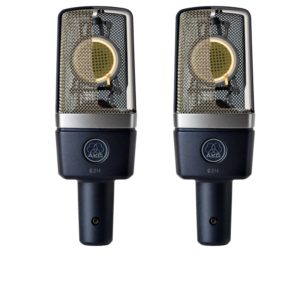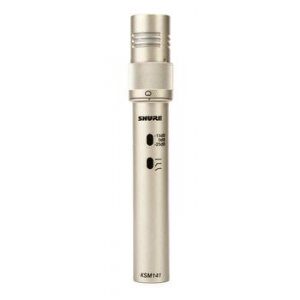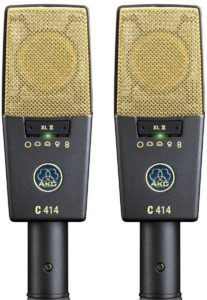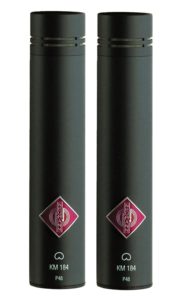What are the best overhead drum mics for recording? Let’s try to figure out what this means.

Drums possess the most complex array of tones out of almost any instrument, and as a result, recording them is a real challenge. To record drums effectively, you need mics to handle the loud attack, the depth of toms and bass drums, and the high shimmer of cymbals.
Not only that, but drums also span a large physical area meaning mics need to pick up sound from right across a kit.
The modern drum mic setup takes advantage of many purpose-built mics. However, in the 60s and 70s, Glyn Johns, who engineered albums by The Who and Led Zeppelin, pioneered a three-mic drum recording technique where he’d use two overhead mics combined with one kick drum mic.
It is possible to get a great sound from this technique, and it’s still used today. That is because the most crucial element of a drum mic setup is almost invariably the overheads. You can’t record drums without them. It just wouldn’t work.
So, without further ado, let’s look at the four best overhead microphones for drums:
Top 4 Best Overhead Drum Mics for Recording:
| Image | Model | Price |
|---|---|---|
 | AKG Pro Audio C214(Top Pick) | Check Price |
 | Shure KSM141/S | Check Price |
 | AKG Pro Audio C414 XLII | Check Price |
 | Neumann KM183 MT | Check Price |
AKG Pro Audio C214 (Editor’s Choice)
The AKG C414 was famous for its vast range of selections. However, let us face it, if you want to record drums, you probably don’t need them. It is AKG’s answer to the overhead drum mic industry. You get a stereo-matched pair in the box for a great price. They’re great mics and have a familiar sound akin to AKG’s higher-end models.
These mics are fixed cardioid mics, meaning they only have the cardioid pickup pattern available. That is ideal for drums – you won’t need anything else with this mic as it can obtain a great stereo-image with that setting.
Build and Features
The C214 is minimal on the features. That is partly how AKG got the cost so low. You don’t need a full C414 feature set for the average drum studio, and AKG were mindful of that. Instead, they put a great-sounding mic into the hands of many at an affordable price. It comes with some AKG goodies like their spider shock-mount, and the build quality is extraordinary for the price.
Sound Quality
These mics sound particularly good on drums. That’s great because that’s what we’re here for! They pick up cymbal sounds with a smoothness that doesn’t get overly washy or shrill when played hard.
Toms and other drums sound fat and smooth but not too boomy, as this mic features a dead-flat response below 500Hz and rolls off near 75Hz. Once again, it’s excellent for drum mics as you won’t need to worry about EQ’ing these areas so much. This mic can handle high-gain close-miking duties on drums and snares too.
Overall, they have an excellent response to transient sounds that aren’t hindered in their bite while also remaining natural and smooth. The only downside is that you wouldn’t want to use this as a close mic on anything lower than a tom because of its low-frequency response. But, of course, that is somewhat irrelevant here – its low-frequency roll-off is perfect for overhead miking!
AKG Pro Audio C414 XLII
An evolution of the legendary AKG C414, the C414 XLII is a widely recognized beast of a microphone that can handle almost every audio source with exquisite ease. Such is the AKG C414’s flexible status that it’s cited as a tremendous vocal mic as well as a fantastic drum overhead mic. In the aluminum flight case/box, you receive an array of accessories. These include a shock mount with a bayonet release system, a pop shield, and a wind-sock.
Build and Features
It’s a substantially built mic, not the smallest by any means but tough and relatively heavy.
One of the top-selling features of this mic is its plethora of controls.
These include a pad setting for particularly loud sources. That extends from 6dB through to 12dB and 18dB settings.
There’s also a bass-cut section with 40Hz, 80Hz, or 160Hz settings, which you can use to reduce unwanted rumbles and eliminate subsonic noise. A slope of 12dB/octave is the default for 40Hz and 80Hz settings, and for 160Hz, it’s 6dB/octave. Additionally, the mic comes with an astounding amount of polar patterns. These include omnidirectional, wide cardioid, cardioid, hyper-cardioid, and figure of 8.
You can even select between these patterns, though, combining two polar patterns. So, for example, you could combine wide cardioid with cardioid for an overhead sound with a little more ambiance. Likewise, combining hyper-cardioid with figure 8 is interesting! Overall, the mic allows for 27 different settings!
Sound Quality
This mic quite simply sounds very good. It performs very well in all manner of diagnostic tests on a variety of sources. It’s warm, natural, rich, and open. Ideally suited for picking up whole kits, it excels when used in a minimal miking setup to obtain those 70s Glyn Johns recordings.
You can pick up extraordinary detail, and it all sounds very recognizable and real, which is simply what you need from a drum overhead. When coupled with single drum mics in a more comprehensive modern setup, this mic still excels. It offers flexibility, unlike many others. For its price, when compared to other flagship mics, it suddenly doesn’t look too expensive for everything you get.
In our opinion, the C414 XLII is the best overhead drum mics for recording.
Neumann KM183 MT
This mic is a small diaphragm condenser with a fixed omnidirectional polar pattern. Neumann’s 180 series is supplied in either nickel or matte lack in a wooden box with a quality clip and windscreen. It’s just one digit away from the KM184, a cardioid mic, and the 185, a hypercardioid. They all fill a different niche and can be used to record drums, particularly appealing with the 183 and 184.
Build and Features
The 183 is an omnidirectional condenser, meaning it’s best suited for mic duties in well-treated rooms, which sound good as a whole. As an omnidirectional mic, the 183 is useful when there’s no need to filter out background noise. It also makes it useful for capturing sounds from expansive drum kits or percussion groups. It’s quite a niche mic for the price, but with Neumann’s legendary name attached to it and sublime engineering, it’s justified.
Sound Quality
The 183 has a super flat response. It’s just supremely faithful to the sound it’s picking up. It has no roll-off, no attenuation across any frequency. If you have a good room and a lovely sounding kit, this mic will pick it up with supreme accuracy. Many claim it’s a one-trick pony, but we’re talking about overhead mics for drums here, and it will carry that job out with outstanding accuracy. It is an Omni mic. That’s why you need a good room, as it will pick up unfavorable echoes like nothing else.
Shure KSM141/SL

No mic shoot-out is complete without a Shure mic. This little mic is a multi-pattern mic with cardioid and Omni settings, adjustable pad settings, and even a switch for adjusting the roll-off per octave. It’s a quirky mic, and its settings stand it apart from other similar-sized mics.
Features
These are feature-packed for a small diaphragm studio condenser. That makes them somewhat of a swiss-army knife around fixed-blade mics like the KM series. The cardioid and Omni switch means you have two settings to try – you can even combine them with pleasing effects. The low cut-off features an 18dB/octave at 80Hz or a smoother 6dB/octave at 115Hz. It also has a 15 or 25dB pad setting, enhancing its capability of capturing loud sources.
Sound Quality
It is a snappy mic, great for picking up drum transients. It has a quick response that has a fair amount of bite while remaining smooth and controlled. They can be set up as accurate mics to achieve a detailed stereo image rich in 3D detail. In addition, the mic’s ability to pick up high frequencies with more-than-adequate brightness but not harshness makes it excellent for picking up cymbals.
How to Pick the Best Overhead Drum Microphones
The only type of mics that see widespread use from drums is condensers and ribbon mics. Condensers are vastly cheaper than ribbon mics and come in various shapes and sizes, from small diaphragms to large diaphragms.
Neither small nor large is better than the other; it just depends on your preferences. Overhead mics also feature multiple pickup patterns, which you can sometimes change on the mic’s body to modes ranging from super-cardioid to omnidirectional.
Small Diaphragm
Smaller pencil-shaped mics are small-diaphragm mics, and they’re generally accepted as more precise. In addition, they respond more quickly to the transient sounds found in drums and percussion. That makes them more suitable for overheads intended to pick up the cymbals and higher frequencies. They don’t usually have as much of a sonic character as large diaphragm mics, though.
Large Diaphragm
Large-diaphragm mics can sound more natural and less precise. However, they’re used widely for vocals as they make the voice appear more as it sounds in real life. In addition, they produce similar drum results and are perhaps better suited to picking up the whole kit than small diaphragm mics.
Supercardioid
These provide a focussed image, which is not suitable for larger sets of drums. They also won’t pick up much off-axis noise originating from your mic pickup pattern outside the target zone. These could be useful if you have many loud instruments packed into a room and record drums using overheads without capturing too much ambiance.
Cardioid
Widely seen as the most useful pickup pattern for drums, cardioid mics, when used as overheads, provide practical stereo imaging while picking up just the right amount of room noise if set up correctly.
Omni
This pickup pattern can be useful if you want a more ambient and all-over sound for creative reasons or if you have a great room and a great-sounding kit. It will reduce the precision of your stereo image, though.
The Best Overhead Drum Microphone Is…
So, what’s the best mic for drum overheads?
Going by the straight quality and its powerful selection of effects, the AKG C414 XLII trounces these opponents. It’s the mic that many people say they wish they bought earlier. It’s suited to so many things in and around drums, it’s sure to stand any time test, and it will pay for itself through its enormous flexibility.
The Neumann KM183 is a quirky little mic that many people adore. Unfortunately, some people don’t see the attraction, while the Shure mic has the unique offering of multiple features packed into its small, high-precision shell. For achieving drum sounds on a budget, though, the C214s have to weigh in as the best all-around overhead mics.
They pack a legendary sound in AKG’s sublime build quality. While they are suitable for recording other instruments, they do excel in their overhead mic duties. In addition, they have an appealing sculpted low-end that gets warm mid frequencies out of your drums while reducing your need to battle the lows in your mix. Perfect for amateur recordists and studios.